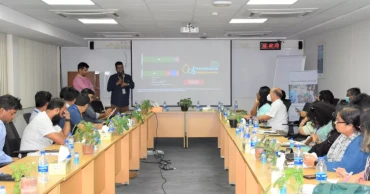Hypoxemia
Ensuring access to medical oxygen would save more lives from hypoxemia: Experts
Ensuring access to medical oxygen would save more lives from hypoxemia, experts said Wednesday.
"Around 21 percent of the air around us is oxygen, and we only require 19.5 percent oxygen in the air we breathe. However, that is not the case for those with less oxygen in their blood – a health condition known as hypoxemia," they added.
Around the world, 73 million people suffer from hypoxemia each year, of which 32 million are children. In Bangladesh, about 42 percent of the children who visit the secondary hospital with pneumonia suffer from hypoxemia.
The experts were speaking at an evidence-sharing session organised by the Icddr,b and Data for Impact (D4I), an initiative of the University of North Carolina at Chapel Hill, in Dhaka to mark World Pneumonia Day 2022 and discuss the importance of medical oxygen security.
The session focused on the overall availability of oxygen therapy in Bangladesh, along with low-cost innovations that can supplement health systems and address medical oxygen security.
Read: Newborn twins die due to lack of oxygen at private clinic in Chattogram
Dr Ahmed Ehsanur Rahman, associate scientist at the Maternal and Child Health Division at icddr,b, said anyone suffering from hypoxemia requires oxygen as a medical therapy.
Hypoxemia can happen due to a range of medical conditions, largely due to respiratory distress caused by pneumonia, malaria, sepsis, tuberculosis, chronic obstructive pulmonary disease (COPD), heart disease, and asthma, among others.
According to the Bangladesh Health Facility Survey 2017, less than one-fourth of health facilities have any of the three oxygen systems – compressed gas systems, portable oxygen concentrators (POCs) or liquid oxygen systems. Among these, an oxygen concentrator was available in 13 percent of facilities, while only 21 percent of facilities had filled an oxygen cylinder with flow metre. Only 6 percent of facilities had an oxygen distribution system and pulse oximetre.
Another icddr,b-led study conducted in April-May 2020 revealed that out of 60 district hospitals in Bangladesh, 72 percent had pulse oximetry devices, and only 7 percent had the provision to perform arterial blood gas analysis.
Read: 2 liquid oxygen plants to be established: Health Minister
In the case of other sources to provide oxygen security, 18 percent had oxygen concentrators, 2 percent had liquid oxygen in bulk storage tanks, and 3 percent had an on-site oxygen plant. Central and sub-central piping was available in only 17 percent of district hospitals, and only 20 percent had flow-splitters available on the day of the visit.
One-fourth of the district hospitals had the provision to provide low-flow oxygen therapy with non-invasive ventilation, whereas only 7 percent could provide basic oxygen therapy with both non-invasive and invasive ventilation. However, due to the Covid-19 pandemic-induced extraordinary demand for oxygen supply, the situation may have improved in these hospitals.
The meeting ended with the announcement that Bangladesh will co-chair The Lancet Global Health Commission on medical oxygen security in 2024.
It is expected that this commission will shed light on the burden of hypoxemia, how to define and measure oxygen access, which oxygen solutions work best in different settings, and how to generate the financing and political will to achieve transformational change.
Read: Another Indian Oxygen Express arrives with 200 MT of medical oxygen
3 years ago

